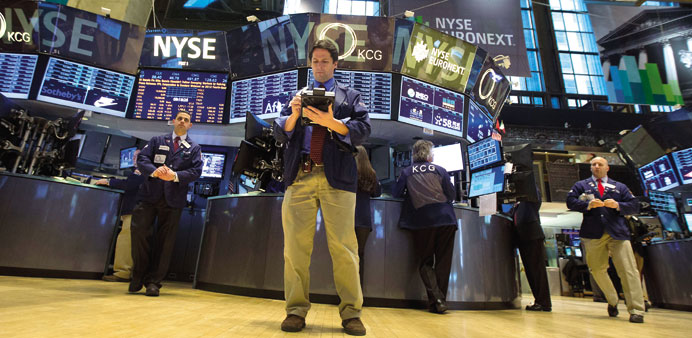Traders work on the floor of the New York Stock Exchange. Shares in US industrial companies and exporters may come under pressure through year end as the prospect of an interest rate hike from the Federal Reserve strengthens the dollar and weighs on Corporate America, according to analysts.
Reuters/New York
Shares in US industrial companies and exporters may come under pressure through year end as the prospect of an interest rate hike from the Federal Reserve strengthens the dollar and weighs on Corporate America, analysts said.
Consumer stocks, the best performers on the S&P 500 so far this year, could continue to lead.
With Fed officials making it clear that the central bank is looking to raise rates by year end, the already strong dollar could rise even more as investors shift funds to the US, taking advantage of rates that are higher than in the eurozone or Japan, where central banks are loosening policy.
The greenback is on track to close October at its highest in more than 12 years against the currencies of the major US trading partners, according to the St Louis Fed’s trade-weighted dollar index.
That raises the possibility that companies exposed overseas will see a pinch if exports become pricier. “You’re going to see a very competitive environment, one which some countries may use currency devaluation as a way to try to enhance their position,” said Bruce McCain, chief investment strategist at Key Private Bank in Cleveland.
“For that reason, we don’t see any near-term letup in the pressure that the dollar is likely going to exert on US exporters.”
During the first quarter, while the greenback kept rising sharply, stocks in the industrial, financial, energy and utilities sectors posted negative returns.
The best S&P 500 sector performers were healthcare and consumer discretionary names.
Wall Street’s recent rebound, however, has been led by these internationally exposed names, in part because they represented a better value for investors.
As foreign markets rebounded in October, companies in the top 10% in terms of international revenue in the S&P 500 gained 15%, according to Bespoke Investment Group, a research firm in Harrison, New York. That may change if the dollar ventures into territory not seen in years.
Should the dollar keep pushing higher, it will pressure large manufacturers who operate overseas. Some, including General Motors and IBM, have already reported hits to the bottom line due to currency translation.
In March, the last time the dollar was this strong, United Technologies’ Chief Executive Officer Greg Hayes said the company assumed “that we’re going to see the euro at parity with the dollar before the year” and so “we have to make sure the business is as lean as possible to offset these headwinds that we can’t control.”
He pointed to the benefit, weighted heavily to the largest companies, that an eventual parity would sharply stimulate consumption in Europe and could help offset the currency headwind.
A stronger dollar is a headwind “more on the Caterpillar side of things, where demand for heavy industry that goes with mining has had the rug pulled out from it,” said David Gilmore, partner at FX Analytics. “If you attach weak global demand to a higher dollar it is troubling for a lot of manufacturers.” If the dollar rises more, US consumers and consumer-oriented companies should benefit because some imports will be cheaper and the strong dollar should keep a lid on energy prices.
The S&P 500 consumer discretionary sector hit a record high Thursday.
Exporters will get a two-fold hit to balance sheets in a strong dollar environment.
Their costs, which are in dollars, will be comparatively higher while their overseas sales will be weaker when they convert from local currencies.
“Many of the big firms have manufacturing in Europe and the hit is (only in currency) translation,” said Scott Lawson, who follows industrials as vice president of Dallas-based investment management firm Westwood Holdings Group.
“But for those that manufacture in the US, it’s not just that their sales and profits are translated back into the US dollar at lower rates, but they face price competition within foreign markets that is difficult to offset versus the locals.”



